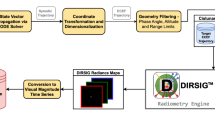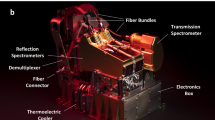Abstract
Direct observation of Earth-like planets is extremely challenging, because their parent stars are about 1010 times brighter but lie just a fraction of an arcsecond away1. In space, the twinkle of the atmosphere that would smear out the light is gone, but the problems of light scatter and diffraction in telescopes remain. The two proposed solutions—a coronagraph internal to a telescope and nulling interferometry from formation-flying telescopes—both require exceedingly clean wavefront control in the optics2. An attractive variation to the coronagraph is to place an occulting shield outside the telescope, blocking the starlight before it even enters the optical path3. Diffraction and scatter around or through the occulter, however, have limited effective suppression in practically sized missions4,5,6. Here I report an occulter design that would achieve the required suppression and can be built with existing technology. The compact mission architecture of a coronagraph is traded for the inconvenience of two spacecraft, but the daunting optics challenges are replaced with a simple deployable sheet 30 to 50 m in diameter. When such an occulter is flown in formation with a telescope of at least one metre aperture, terrestrial planets could be seen and studied around stars to a distance of ten parsecs.



Similar content being viewed by others
References
Seager, S. The search for extra-solar Earth-like planets. Earth Planet. Sci. Lett. 208, 113–124 (2003)
Henry, C. et al. Terrestrial planet finder interferometer: architecture, mission design, and technology development. Proc. Soc. Photo-Opt. Instrum. Eng. 5491, 265–274 (2004)
Marchal, C. Concept of a space telescope able to see the planets and even the satellites around the nearest stars. Acta Astronaut. 12, 195–201 (1985)
Copi, C. J. & Starkman, G. D. The big occulting steerable satellite (BOSS). Astrophys. J. 532, 581–592 (2000)
Schultz, A. B. et al. UMBRAS: a matched occulter and telescope for imaging extrasolar planets. Proc. Soc. Photo-Opt. Instrum. Eng. 4860, 54–61 (2003)
Jordan, I. J. E. et al. Apodized square aperture plus occulter concept for TPF. Proc. Soc. Photo-Opt. Instrum. Eng. 5487, 1391–1401 (2004)
Kasdin, N. J., Vanderbei, R. J., Spergel, D. N. & Littman, M. G. Extrasolar planet finding via optimal apodized and shaped pupil coronagraphs. Astrophys. J. 582, 1147–1161 (2003)
Vanderbei, R. J., Spergel, D. N. & Kasdin, N. J. Circularly symmetric apodization via star-shaped masks. Astrophys. J. 599, 686–694 (2003)
Cash, W., Kasdin, J., Seager, S. & Arenberg, J. Direct studies of exo-planets with the New Worlds Observer. Proc. Soc. Photo-Opt. Instrum. Eng. 5899, 274–285 (2005)
Acknowledgements
I thank R. Vanderbei, J. Kasdin, M. Lieber, and J. Arenberg for advice, discussion and encouragement. I thank D. Feldkhun, A. Lo, N. Rajan, E. Schindhelm, and W. Simmons for investigating alternative approaches and verifying the results of this paper. I wish to thank R. Cassanova and the NASA Institute for Advanced Concepts for financial support and encouragement of the work from its early stages.
Author information
Authors and Affiliations
Corresponding author
Ethics declarations
Competing interests
Reprints and permissions information is available at npg.nature.com/reprintsandpermissions. The author declares no competing financial interests.
Supplementary information
Supplementary Notes
This file contains Supplementary Information, including Supplementary Figures 1–3 and two references. (PDF 76 kb)
Rights and permissions
About this article
Cite this article
Cash, W. Detection of Earth-like planets around nearby stars using a petal-shaped occulter. Nature 442, 51–53 (2006). https://doi.org/10.1038/nature04930
Received:
Accepted:
Issue Date:
DOI: https://doi.org/10.1038/nature04930
- Springer Nature Limited
This article is cited by
-
Occulter to earth: prospects for studying earth-like planets with the E-ELT and a space-based occulter
Experimental Astronomy (2022)
-
High contrast observations of bright stars with a starshade
Experimental Astronomy (2017)
-
Control of orientation for spacecraft formations in the vicinity of the Sun-Earth L2 libration point
Science China Physics, Mechanics & Astronomy (2014)
-
Unbalanced nulling interferometer and precise wavefront control
Optical Review (2013)
-
Generation 2 testbed of Fresnel imager: first results on the sky
Experimental Astronomy (2011)





